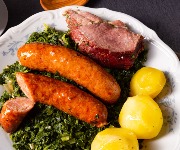Well Hung Beef
Hanging beef in the right environment and at the right temperature pretty much guarantees that you're adding flavour and tenderness to the meat
Most countries can be represented by a bit of food, which is either flown with pride by them like some sort of edible national flag or is used as an emblem of ridicule by other countries. Italy has pasta; Malaysia has satay; Belgium has a choice between moules, frites and chocolate, although I suspect the Swiss want the latter; Japan has raw fish; France, according to itself, has everything, according to us, has frogs’ legs and according to neo-con Americans, has cheese.
We have beef. Our fabulous, aged, marbled, beef. The type of stuff that conjures up images of vast rib joints towering above everything else on a table, supported by foothills of goose fat roasted spuds, paddling pool sized Yorkshire puddings, agreeable quantities of inky dark claret and quite possibly a chubby, ruddy-faced chap in a tricorn hat. Nothing ridiculous about that at all.
The true beef of England comes from the traditional breeds of this sceptr’d isle, magnificent beasts like the Herefords, the South Devon’s, the Shorthorns and the Highland, which have been grown for their meat (not their milk) for centuries. If these are kept in the right way – outside - fed in the right way, on the right stuff – grass - and, crucially, hung in the right way, you can almost hear Land of Hope and Glory every time you get your hands on some.
What hanging allows is time. Time for the enzymes to break down the fibres in the meat, making it tender, and time for some moisture to leave the meat, thereby concentrating the flavour. Surely that’s what it all boils down to isn’t it? Texture and taste.
Hanging beef in the right environment and at the right temperature pretty much guarantees that you’re adding flavour and tenderness to the meat. Cut straight from a freshly killed animal and popped under a grill, almost any bit of beef would be as tough and as unyielding to any normal masticator as the outer skin of the football that won us the World Cup in ’66. I can’t be sure it would share the same taste, but I doubt what little taste it had would be noticed behind the relentless chewing required.
Debate rages (gently, and most often over counters of the nation’s independent butchers) about how long the beef should hang for. You’re not going to notice much difference in either taste or tenderness before about 10 days. It’s after this that flavour starts mounting up. Most British butchers proud of what they do will leave beef in the (well ventilated) chiller for at least 21 days, with 28 days generally being regarded as ticking all the boxes and specialist producers not relenting until 5 weeks are up.
It is perfectly acceptable to ask for it to be left hanging for longer. Barry, my very own friendly village butcher, happily leaves some up for two months for one of his customers.
I should make it clear that we’re talking about hanging whole or half an animal or at least a sizeable joint on the bone. Anyone attempting to hang a rolled, boned joint, or a single slab of sirloin steak for any decent length of time is going to be disappointed and quite possibly sick. And mince is just silly.
Obviously an inferior beast, hung for the same amount of time as, say, a side of 18 month old grass fed Hereford, will simply not compare. Equally, that same Hereford given only a week to hang is not only a total waste of one of God’s most magnificent food sources, it will probably make the rangy old Fresian that’s been hung for twice as long seem succulent.
And what of the claims of “ageing” by the supermarkets? At the risk of causing a wave of legally supported denial, these massive operations cannot afford to hang the quantities of meat they expect to retail on a daily basis for as long as a smaller business is able. Not only do they need to cater to demand, but they also need to minimise the risk. While they do allow the animals to hang for a certain amount of time, they ultimately vacuum-pack the joints and leave them to “age” in a sad, hermetic state. The main tragedy of this is that no drying can be achieved, which means that there can be no concentration of flavour, which leads to an unremarkable sowhatishness piece of meat.
One final word about food miles. Don’t be too seduced by local provenance. A shaggy haired Highland coo, for example, has evolved to live happily in the wretched weather thrown at it in Scotland. What it feeds on and how it lays down the food in the way of muscle and fat, will offer up, more often than not (and if properly prepared), a fantastic piece of meat, wherever it ultimately is eaten. And frankly, a lorry load of beef trundling down from the Cairngorms is a tiny carbon footprint compared to the size trodden by the quantity of lamb that is brought to these shores from New Zealand.
So when the comestible flag of Great Britain is run up the flagpole, I’ll be the first to stand to attention, saluting while I fight back manly tears of national pride, but only if that flag is well hung.
Also worth your attention:
Most Recent
Comments
Be the first to comment
Do you want to comment on this article? You need to be signed in for this feature








